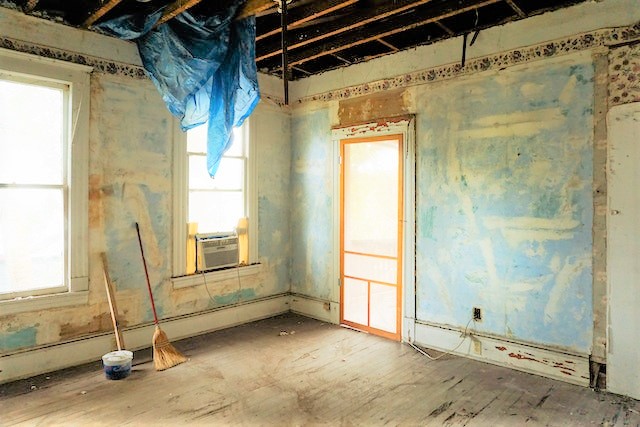Last updated on April 5th, 2023 at 05:14 am
When you rent a home or an apartment, you and the landlord each have certain obligations. As a tenant, you must pay rent and take care of the property. In exchange, your landlord should make repairs and keep the property in a habitable condition.
When the property’s condition becomes uninhabitable it, unsurprisingly, throws a wrench in a landlord-tenant relationship. Of course, some landlords do the bare minimum to maintain your rental unit to the point of making it unlivable.
Someone living in a rented space might be wondering, What happens when a house is deemed uninhabitable? If a landlord fails to maintain a rental unit (rendering it unlivable), you, as the tenant, have the legal grounds to sue the landlord, end the lease, or withhold rent.
Uninhabitable House Law
Most jurisdictions require residential rental unit leases to include an implied warranty of habitability. This warranty mandates landlords to keep their rental property in a livable condition – even if the lease doesn’t require them to specifically repair their rental units.
Additionally, the warranty mandates the tenant to pay rent and the landlord to keep their property in a habitable condition. This makes it easier for the tenant to compel the landlord to make essential repairs (when required to). When a landlord breaches the warranty, the law allows the tenant the following remedies:
- To withhold rent until the landlord repairs the rental property
- To withhold rent and use the money to pay for the repairs instead
- To sue the landlord for damages
All states (except Arkansas) recognize this warranty, either by statutes regarding habitability or by the decisions of each state’s Supreme Court ruling.
Some states implied warranty of habitability lays out specific requirements for landlords to provide habitable rentals. Other states leave it up to interpretation. In a way, the implied warranty of habitability also protects poor tenants (with no money to repair damages on a rental property) from abusive landlords.
How to Report an Unlivable House

Before reporting an uninhabitable home, contact the landlord first. It’s the easiest way to resolve any housing quality or safety issues in an unlivable home. That way, you’ll give the landlord an opportunity to take care of the issues.
But if the landlord fails to take action, immediately report the unlivable home to the local health department – especially if the issues are numerous, conditions incredibly unsafe, and the damage severe. Issues to report to the landlord include (but aren’t limited to):
- Non-functioning plumbing fixtures
- Garbage and waste removal
- Lack of proper utilities within the rental unit
- Structural issues such as a leaking roof or collapsing floor
- Mold within living spaces
- Pest infestation
Once you file a complaint, a health inspector will then arrange to inspect the home for health code violations. Prepare a report. And later send the report and violations to the landlord. You can also call electrical and plumbing inspectors to assess the home’s conditions which you think can be a major annoyance to human health.
Tenants’ Rights If House Is Uninhabitable
Tenant’s rights to a safe and livable rental space are condensed in the legal term “implied warranty of habitability”. This warranty legally implies that when a landlord offers their rental property to a tenant, they promise them a habitable place.
This promise is legally binding even without being written in a lease or otherwise formally agreed upon. So, landlords must provide tenants with a safe and livable rental home. And it doesn’t matter how much rent each tenant pays. Most state landlord-tenant laws require landlords to meet basic requirements, such as:
- Keep roofs, walls, stairs, and other basic structural elements intact and safe
- Maintain cleanliness in hallways, stairways, and in all other common areas
- Keep all electrical systems operating safely
- Supply water and heat in reasonable amounts at specific times
- Exterminate all rodents and other pests from the property
- Take responsible measures to prevent criminal intrusions
- Keep rental spaces free from environmental hazards
What Are Uninhabitable Living Conditions?

This question often comes up when an unhappy tenant needs their landlord to solve impending disputes. That said, there’s no specific legal standard around what makes a rented living space uninhabitable. But what makes a home unsafe to inhabit depends on a number of factors, such as:
- Significant structural damage which may require everyone to evacuate
- Major mold outbreaks can cause major health issues
- Extreme temperatures (such as excessive cold or heat)
- Lack of functioning plumbing and electrical fixtures
- Serious animal or insect infestations that pose a threat to human health
- Lack of functioning smoke alarms
- Lack of proper security features (such as a missing door or window)
Sometimes a home that’s inhabitable for someone can be unlivable for another. So before renting a home, ensure it has all the basic tenets of habitability.
Uninhabitable Living Conditions Illinois
In Illinois, a landlord’s obligation to provide a habitable rental unit is governed by law and specifically a Supreme Court ruling. And this ruling, among others, establishes the implied warranty of habitability. A home in Illinois is deemed uninhabitable when:
- Infested with pests such as insects and rodents
- Contains hazardous levels of radon
Tenants in Illinois must request repairs in writing. The landlord will then have a fortnight to make repairs after receiving the notice.
Uninhabitable Living Conditions California
In California, tenants must enter a rental agreement with a landlord (either oral or written) before residing in a rental unit. House laws in California allow tenants the right to a habitable rental property or due process for evictions. A home in California is deemed uninhabitable when it has:
- High concentration levels of lead paint
- Infestation of bed bugs and other pests
- Mold growth
- Unsanitary conditions
- Improper ventilation
- Asbestos (especially in rental units built before 1979)
- Possible contamination of a gas or sewage leak
California tenants have numerous protections and rights than they do in other states.
Uninhabitable Living Conditions Georgia
Under Georgia laws, rental leases and landlord-tenant agreements can be implied, written, or oral. Both landlords and tenants have rights and responsibilities. And different notice requirements – landlords give 60 days’ notice to terminate a lease, while tenants provide a 30 days notice.
Uninhabitable Living Conditions Texas
In Texas, the law requires landlords to give notice before tenants enter a rental unit. But it doesn’t specify how much. So, landlords and tenants are free to set their own terms in the lease agreement. What’s considered uninhabitable living for a tenant in Texas?
Texas landlord-tenant laws are relatively broad, but they simply state that anything affecting the physical health or safety of a tenant makes their rental unit unlivable. There’s also an exception of hot water supply. State laws deem a rental unit unlivable if the landlord fails to provide a hot water supply at a minimum of 120 degrees Fahrenheit.
In Summary
Before you take any self-help measures as a tenant against your landlord, make sure to first check whether they’re legal in the state you live. For example, if you withhold rent In a state where it’s not recognized as a tenant remedy, your tenancy may be terminated (or you may get evicted) on grounds of breaching your lease agreement terms.
